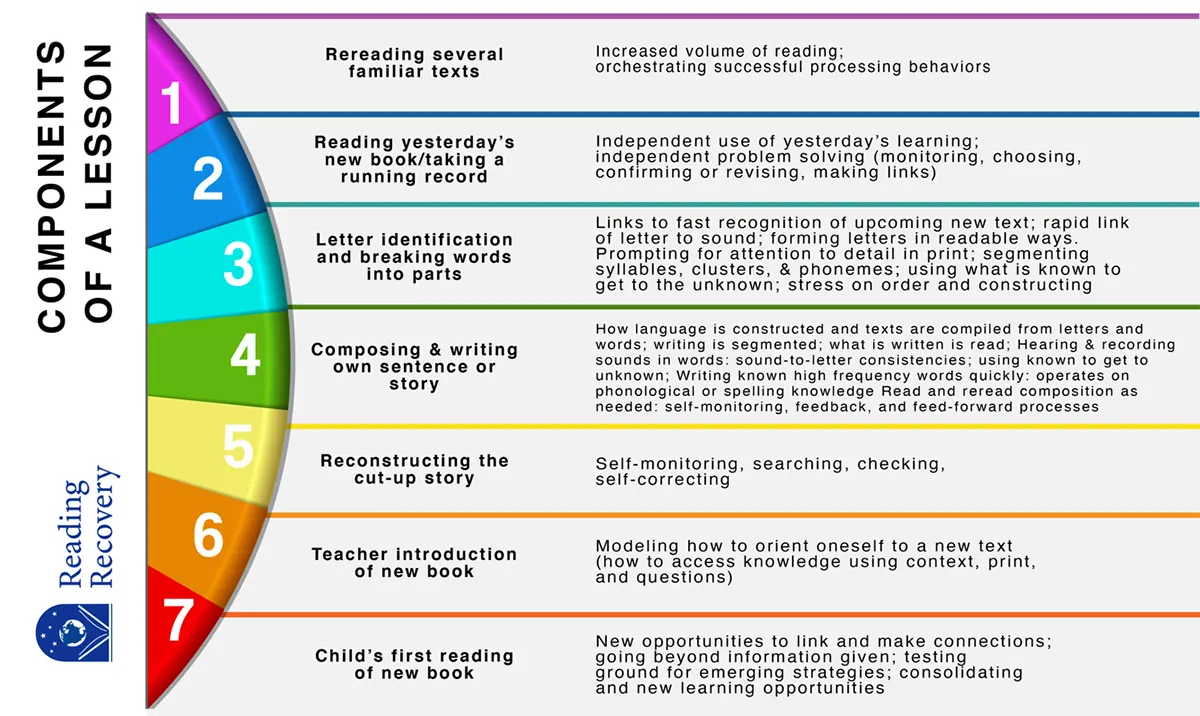The Reading Recovery Lesson
The components of Reading Recovery lessons were tested in early studies by Marie Clay. The activities were “designed to elicit, demand and support a broad-based range of strategic behaviors which comes from knowing how to problem-solve in a variety of ways in both reading and writing” (Clay, 2015b, p. 221). While lessons follow a pattern as described in the graphic of Lesson Components, lesson formats and components are focused on the unique needs of each child.
Daily lessons for Reading Recovery students are essential. Missed lessons minimize the potential of the intervention outcome. For students who have difficulty remembering from day-to-day, the teacher can act as the memory of yesterday’s responses, and can prompt the child accordingly. An intensive intervention like Reading Recovery allows the teacher to closely attend to the daily shifts in the child’s responding. Clay tells us that the power of early intervention is diminished if the child is absent from lessons or if the teacher is unavailable to teach for any reason. “When daily individual teaching is not achieved, the quality of the teaching and the outcomes of the intervention will be seriously affected” (Clay, 2016, p. 21).
Struggling 1st grade readers will continue to struggle in groups. Individual one-to-one instruction is essential for acceleration. Reading Recovery enables most of the children who are the lowest literacy achievers in their class to accelerate their progress in order to catch up with their peers. Individualized Reading Recovery lessons are the most efficient—and often the only—way to give these lowest-achieving children the skills and knowledge they need to succeed. Rather than use a commercially prescribed instructional program, highly trained Reading Recovery teachers diagnose, analyze, and design daily lessons that are specifically tailored to follow the child’s unique learning process.
The learning opportunities provided must draw on the strengths this child has already demonstrated and relate to his new learning needs. The teacher must be tentative, flexible, and immediately responsive to the best opportunity for a particular learner at this moment. (Clay, 2016, p. 24). Through careful observation of behaviors, abilities, and processes as well as systematic records of what children can do and can almost do, teachers can make better decisions about next steps for instruction. When teachers are teaching through student strengths and supporting what they can almost do, they are building the foundations for a self-extending system. The learner can then embrace new learning (DeFord, 2013).
Children making very slow progress and falling behind their peers have to progress faster than their classmates for a time. This rate of progress is referred to as acceleration — increasing the rate of progress (see Jones, 2002). This may seem unreasonable to expect, but Clay provides several factors that help acceleration to occur: one-to- one teaching, lessons that build on each child’s strengths, reading and writing of continuous text, and a teacher who designs a superbly sequenced series of lessons for the particular child without wasting learning time. (See Clay, 2016, pp. 19–21.)

THE JOURNAL OF READING RECOVERY
Spring 2024
Constructing a More Complex Neural Network for Working on Written Language That Learns to Extend Itself by Carol A. Lyons
Reading Recovery IS the Science(s) of Reading and the Art of Teaching by Debra Semm Rich
Predictions of Progress: Charting, Adjusting, and Shaping Individual Lessons by Janice Van Dyke and Melissa Wilde
Teachers Designing for Context: Using Integrity Principles to Design Early Literacy Support in Aotearoa New Zealand by Rebecca Jesson, Judy Aitken, and Yu Liu

